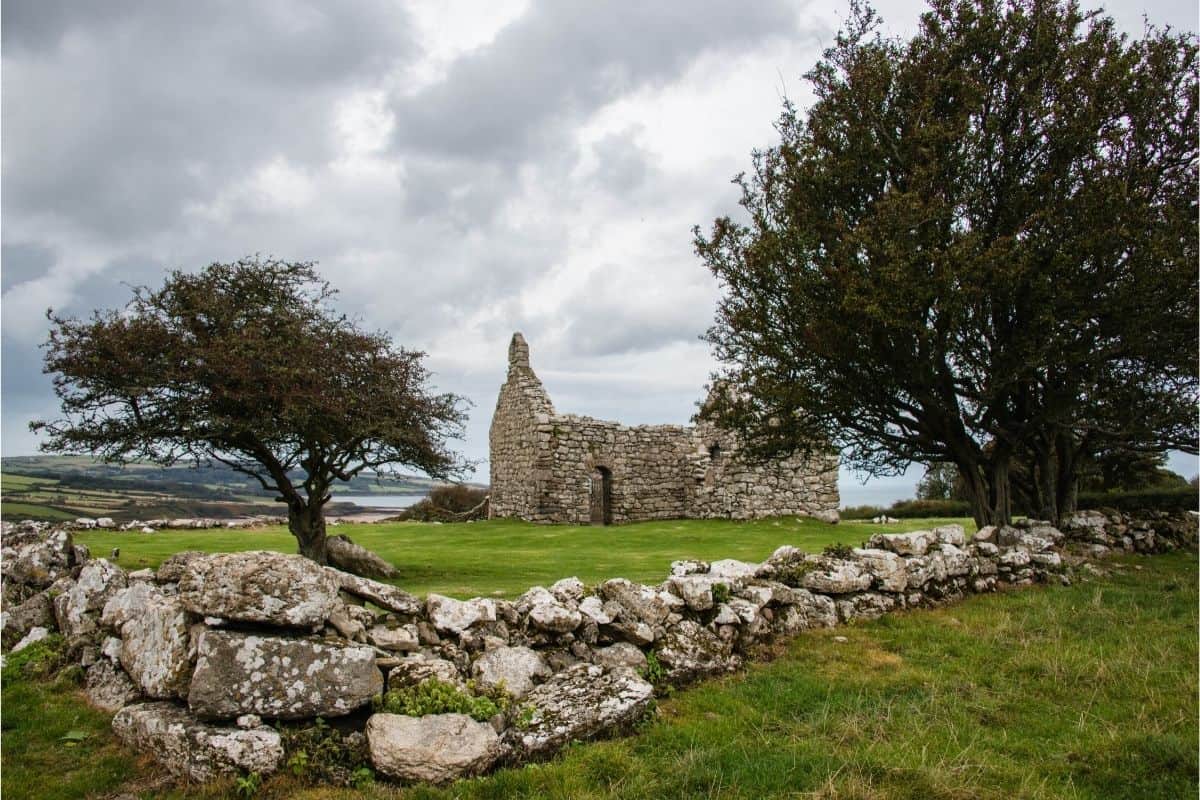Nestled in a quiet corner of the countryside, just a stone’s throw from the small fishing village of Moelfre, are the Lligwy Ruins. They are a collection of ruined buildings and a burial chamber that all date from different periods, giving a fascinating insight into how a tiny spot of the UK changed over time from the Neolithic period right through to the medieval 16th century.
The three sites, Din Lligwy Hut Group (also called the Din Lligwy Stone Settlement), Capel Lligwy, and Lligwy Burial Chamber, are all within a short walking distance of each other, making them a worthwhile excursion if you happen to find yourself in this corner of Anglesey.
So what’s the history of these sites, and why are they worth paying a visit? Let’s tackle them one by one, starting with the most extensive of the three ruins, the Din Lligwy Stone Settlement.
The Din Lligwy Hut Group: An Intriguing Insight into Late Roman Britain
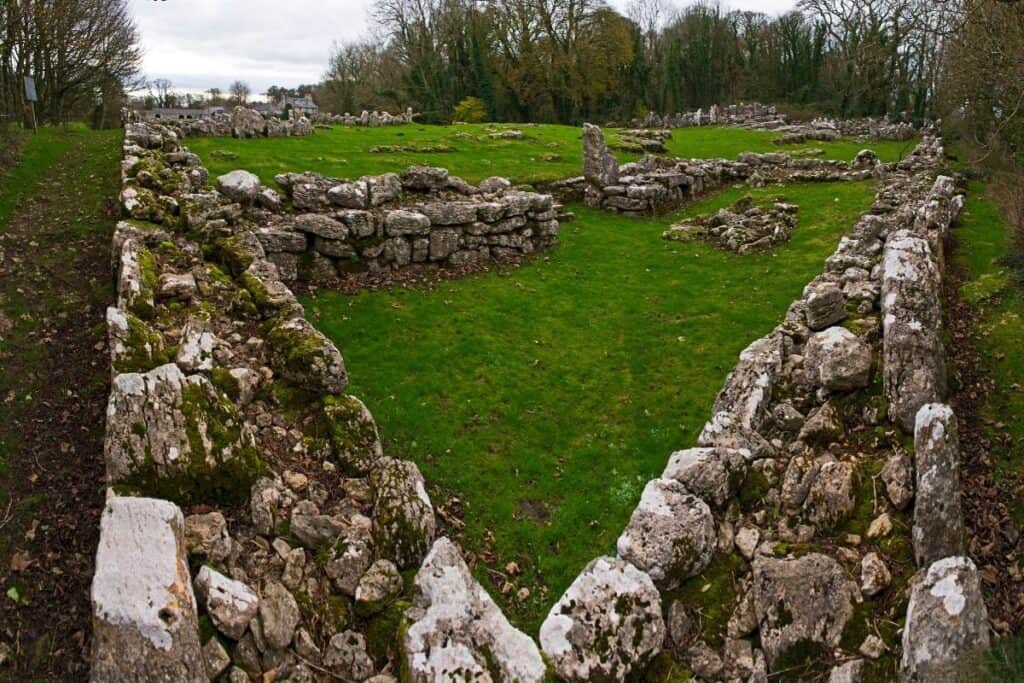
The Din Lligwy Stone Settlement is an incredibly well-preserved 3rd-4th Century fortified village. The site stretches out to cover approximately half an acre and exhibits the ruins of two round huts and several rectangular buildings. The whole site is enclosed by a five-foot stone wall.
Unusually for a Roman site, much of the buildings’ remnants remain above ground, giving you, the visitor, plenty to look at as you make your way around.
It’s thought that the site dates back to the Iron Age, and there have been all sorts of ancient artefacts discovered, mainly during the 1905-1907 excavation works. There have been discoveries of Roman pottery shards, glass, and Roman coins. A silver ingot was found in one of the round huts, indicating that it may have been the residence of the site’s chieftain.

It’s thought that the Celtic settlers would have traded with their Roman invaders, with evidence of iron working, smithing, and smelting. The village itself looks to have been some sort of farmstead, with the walls designed to keep livestock in rather than keep invaders out. The rectangular buildings are thought to have been barns or workshops.
This site really is a hidden little gem tucked away where no one can see it. If this were in a more prominent location, it would attract far more visitors than it does and could even boast a visitor centre and cafe. As it is, you can often enjoy this place all by yourself and imagine what life was like for this small but thriving community hundreds of years ago.
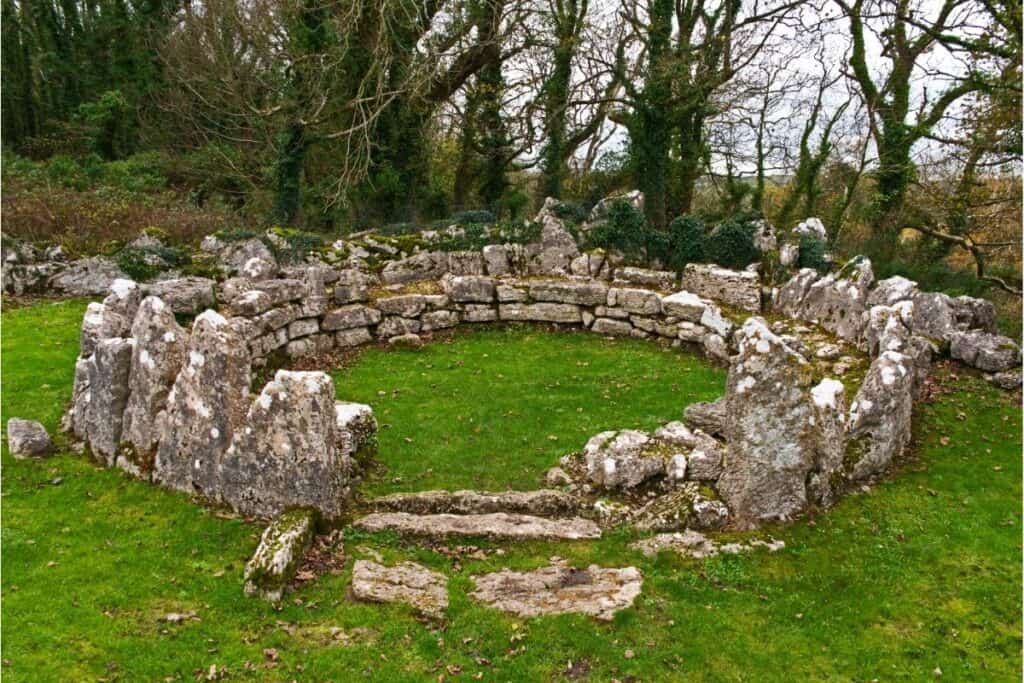
Capel Lligwy
On your way from the road to the Din Lligwy Stone Settlement, you can’t help but notice this ruined chapel that dates back to the 12th century. Unlike Din Lligwy, very little is known about Hen Capel Lligwy (Old Lligwy Chapel).
It’s thought that the church was built in the latter half of the 12th century in the place of an existing timber Celtic church. This was a period whereby many wooden structures were replaced with stone after the end of the Viking raids, a particularly turbulent period in Welsh history.
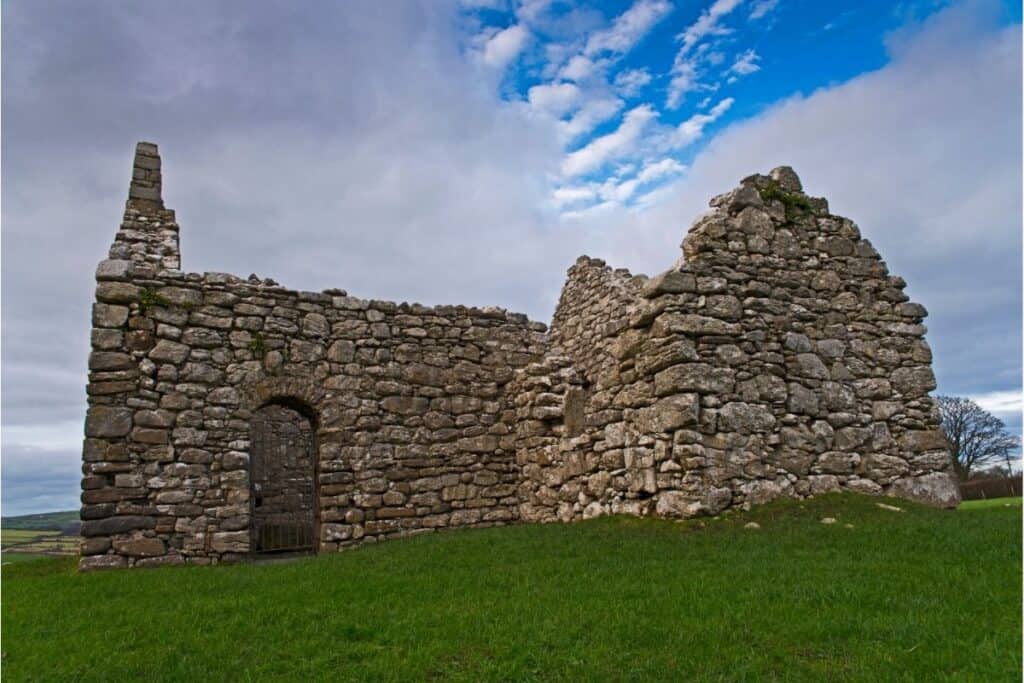
No one knows who the church was dedicated to. However, it is understood that, despite its apparent solitude, the church was likely the focal point of a settlement. It was likely the only stone building and, therefore, the only one to remain after depopulation or consolidation of communities (perhaps inhabitants moved down the hill to Moelfre). It may well have had a link to Din Lligwy, but none has so far been established archaeologically.
In terms of its construction, the church walls were repaired and refurbished in the 14th century, and a small chapel and crypt were added in the early 16th century. You can walk in and around the church unencumbered and take in the tranquillity of this atmospheric and evocative place. It’s easy to see why it was chosen as a place of worship all those centuries ago.
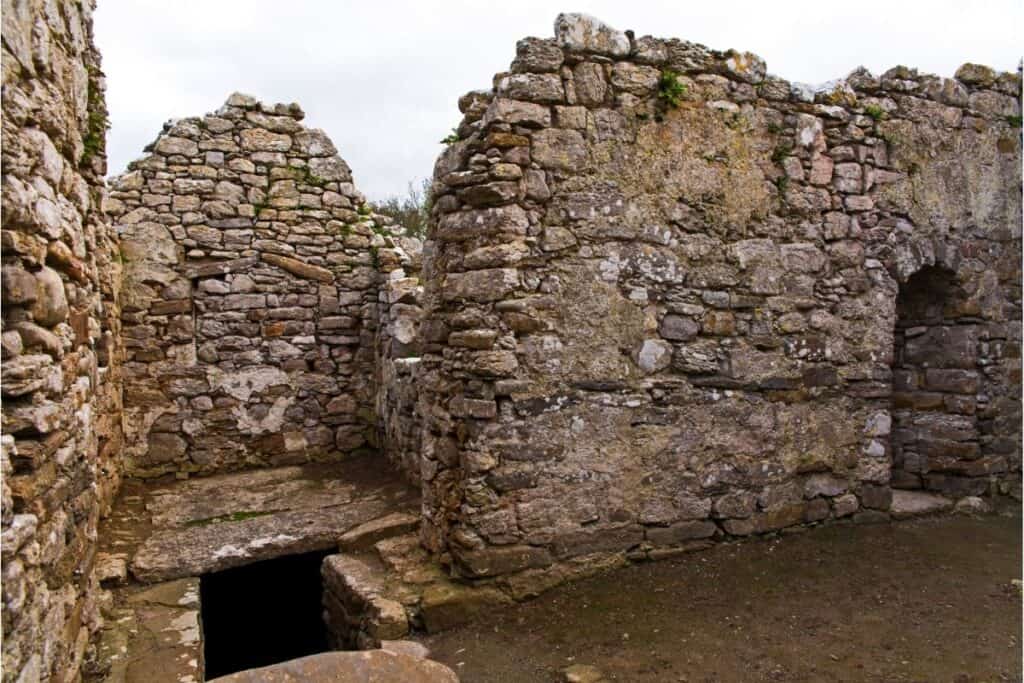
Lligwy Burial Chamber
The Lligwy Burial Chamber is the final stop on our mini-tour of the Lligwy Ruins. This impressive relic is a Neolithic chambered tomb that was constructed some 5,000 years ago.
The tomb consists of a colossal capstone supported by eight upright stones (it’s only in contact with three of them). These uprights are as tall as two metres (6.6 ft) but are submerged in the soil, hiding their true height. Their height is of note because they support a capstone that weighs an incredible 25 tonnes, leaving you to wonder how they managed to elevate such a massive rock that high off the ground.

Originally, the structure would have been covered in earth, with a small passage providing access to a chamber that would have been used to house the dead. It’s not known how many people were actually buried here, but an excavation in 1908 revealed the remains of 15-30 people.
It’s one of many Neolithic burial chambers on the island, with Bryn Celli Ddu and Barclodiad y Gawres other excellent examples of this type of burial mound.
How Do I Get to the Din Lligwy Stone Settlement and the Other Lligwy Ruins Sites?
All of the Lligwy Ruins sites are close to each other and are nestled in the countryside above Moelfre and Lligwy Bay.
To reach the main parking area for the sites:
Take the A5025 towards Moelfre.
At the last roundabout, before entering Moelfre, head straight on (if you’re coming from the Benllech direction) or turn left (if coming from the Amlwch direction) onto a small country lane.
Follow the road as it meanders through the countryside and make your way past the Lligwy Burial Chamber on your left.
Shortly after passing the burial chamber, the road snakes right and then left. Here you will see a lay-by with parking space for 4-5 cars.
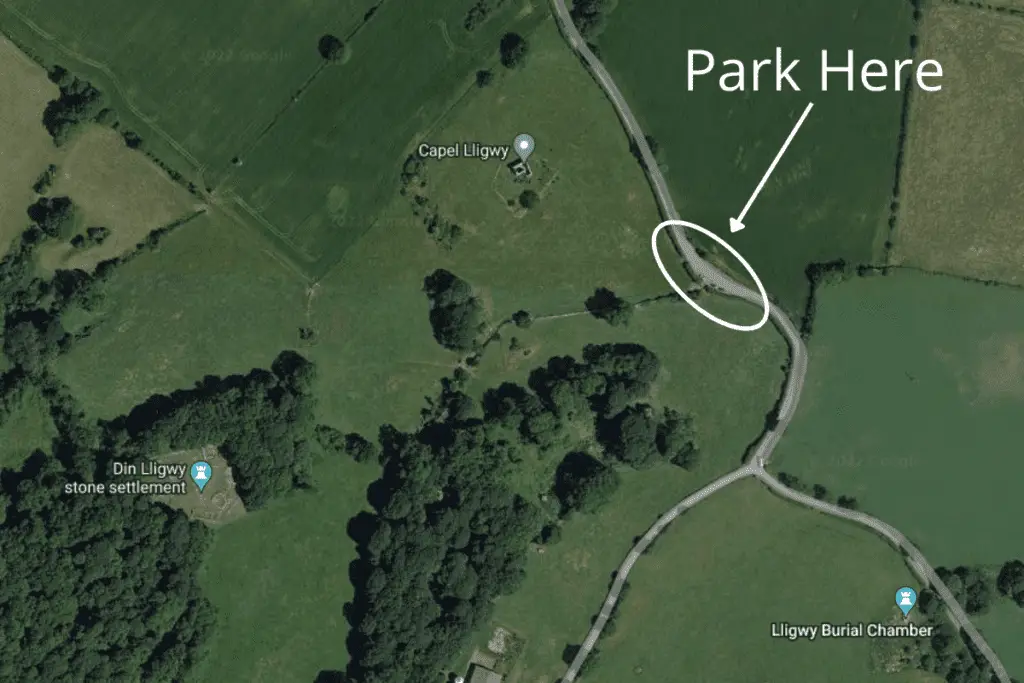
Once you’ve parked up, directions will differ depending on where you want to go.
For Din Lligwy Hut Group: Head through the gate and follow the footpath as it goes through the field with the chapel in it and through some woods before arriving at the ruined settlement.
For Capel Lligwy: You’ll see the chapel from the car. Simply go through the gate into the field and traverse your way across to the site.
For Lligwy Burial Chamber: As you will have passed it on your way, you’ll know exactly where it is. Just retrace your steps back down the road and access the site through a gate into the field. You could potentially park in the passing place opposite the gate, but as it’s a functioning passing place, we wouldn’t recommend it unless you are only going to be there a few minutes.
Lligwy Ruins FAQs
Is There an Entrance Fee to the Lligwy Ruins?
No, there is no entrance fee to any of the sites making up the Lligwy Ruins. You are free to explore all of the sites at your leisure.
Are the Lligwy Ruins Suitable for Access by Wheelchair or Pushchair?
Unfortunately, these sites are not really suitable for wheelchair users or those with pushchairs. The sites are located in the countryside, and there are no paved pathways or roads leading to them. There are also narrow kissing gates to negotiate, making it nearly impossible to access the sites with a wheelchair or pushchair.
Are Dogs Allowed at the Lligwy Ruins?
Yes, dogs are allowed at the Lligwy Ruins, but they must be kept on a lead at all times as there may be livestock in the fields.
When is the Best Time to Visit the Lligwy Ruins?
The best time to visit the Lligwy Ruins is in the spring or summer when the weather is nicer and you can make the most of being outdoors. Concerning the best times of day, the earlier (or later), the better, so you can have these enchanting locations to yourself.
What Other Attractions Are Nearby?
As well as being within easy reach of Din Lligwy, Capel Lligwy, and Lligwy Burial Chamber, the Lligwy Ruins are also near Moelfre and Benllech, which boast plenty of attractions, eateries, and fantastic beaches. Amlwch, with its exciting mining heritage, is also nearby and definitely worth a visit.
What Are the Opening Hours for the Various Lligwy Ruins?
Officially, the opening hours are 10 am to 4 pm, but in practice, you can visit at whatever time you want. The sites are closed on Christmas Eve, Christmas Day, Boxing Day, and New Year’s Day.
Who Owns Din Lligwy, Capel Lligwy, and the Lligwy Burial Chamber?
All of the sites that make up the Lligwy Ruins are under the care and stewardship of Cadw, the historic environment service of the Welsh Government and part of the Tourism and Culture group.

